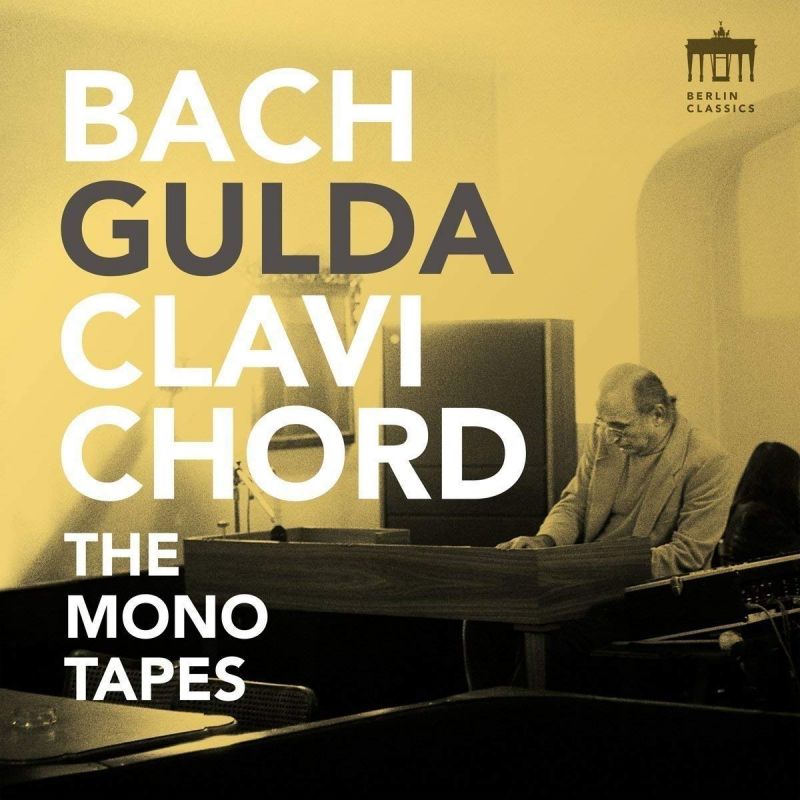Gulda: The Mono Tapes
View record and artist detailsRecord and Artist Details
Composer or Director: Friedrich Gulda, Johann Sebastian Bach
Genre:
Instrumental
Label: Berlin Classics
Magazine Review Date: 09/2018
Media Format: CD or Download
Media Runtime: 60
Mastering:
ADD
Catalogue Number: 0301063BC

Tracks:
| Composition | Artist Credit |
|---|---|
| (Das) Wohltemperierte Klavier, '(The) Well-Tempered Clavier, Movement: Book II, Excerpts |
Johann Sebastian Bach, Composer
Friedrich Gulda, Composer Johann Sebastian Bach, Composer |
| Chromatic Fantasia and Fugue |
Johann Sebastian Bach, Composer
Friedrich Gulda, Composer Johann Sebastian Bach, Composer |
| (6) English Suites, Movement: No. 2 in A minor, BWV807 |
Johann Sebastian Bach, Composer
Johann Sebastian Bach, Composer |
Author: Patrick Rucker
Gulda first became interested in the clavichord in 1971 through the influence of Paul and Limpe Fuchs. Just two years later he was performing the entire Well-Tempered on clavichord. The recordings on this disc, however, date from 1978 79 and were made by Gulda himself on what the producer, Christoph Stickel, describes as ‘rudimentary recording technology … not professionally monitored’. The tapes themselves, owned by Gulda’s pupil Thomas Knapp, who also contributes an interesting background essay to the booklet, were in terrible shape and had to be converted from analogue to digital. This was done, we are assured, in the most conservative manner to preserve Gulda’s playing to the fullest extent possible. The first part of the recording, Preludes and Fugues Nos 5, 23 and 17 and the Chromatic Fantasy, were recorded on a Widmayer clavichord; the second, Preludes and Fugues Nos 10, 20, and 24 and the A minor English Suite, on a Neupert.
To whatever extent Gulda’s experience with the clavichord may have informed his piano-playing, he plays the clavichord like a pianist. I hear little to indicate that he was interested in the potential of the instrument per se or exploring its intrinsic sonorous capacities. Nor is there evidence of a nodding acquaintance with contemporary thinking about matters of tempo, articulation and dance-inspired character in Baroque music which, thanks to the historically informed performance movement, was in full flower at the time.
That said, there is a certain dazzling virtuosity in these performances. One must admire Gulda’s clarity of thought and sheer facility, despite his driven, metronomic tempos and his thick-skinned indifference to the shapes and contours of Bach’s musical gestures. My greatest surprise was that there’s nothing here of the freedom and improvisatory fire that one might have imagined Gulda would bring to Bach from his experience with jazz. It’s difficult to imagine listeners returning to these as they might to other beloved Bach interpretations but they are nevertheless sui generis, thoroughly considered and certainly provide food for thought.
Discover the world's largest classical music catalogue with Presto Music.

Gramophone Digital Club
- Digital Edition
- Digital Archive
- Reviews Database
- Full website access
From £8.75 / month
Subscribe
Gramophone Full Club
- Print Edition
- Digital Edition
- Digital Archive
- Reviews Database
- Full website access
From £11.00 / month
Subscribe
If you are a library, university or other organisation that would be interested in an institutional subscription to Gramophone please click here for further information.




